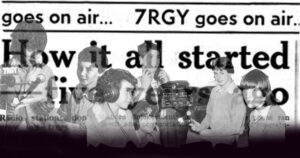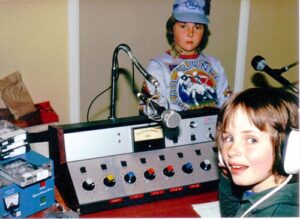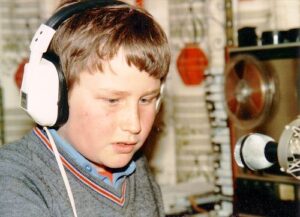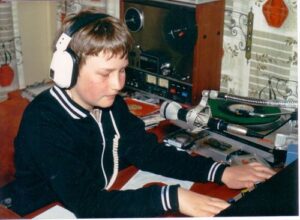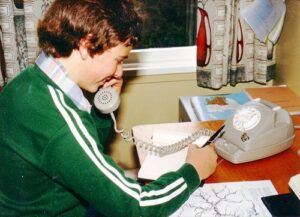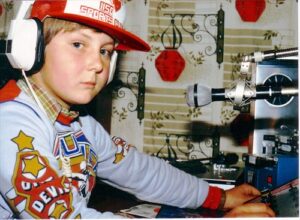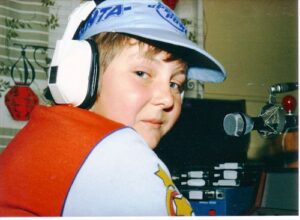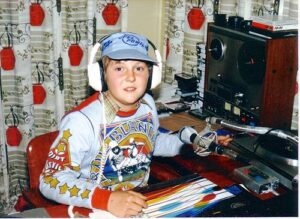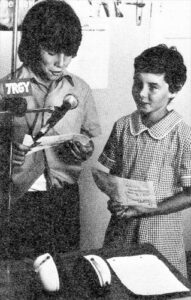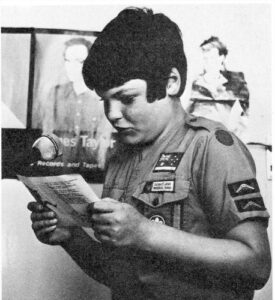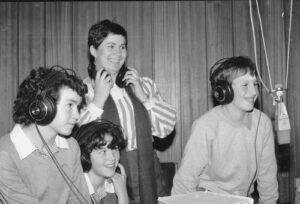The Southernmost Station in the Nation
History
Huon and Kingston FM commenced operations as a narrow casting radio station at Geeveston High School.
- 1978
In December 1978 teacher-librarian Peter Johnston oversaw the establishment of a narrowcasting radio station at the school, initially broadcast was limited to lunch times.
Peter Johnston pushed the project recognising it as an excellent means of giving students additional skill and confidence. He also provided technical support to the students and gave them training in program production. - 1979
Funding to establish 7RGY came from the Schools Commission in 1979 through an Eight thousand five hundred ($8,500.00) grant. - 1980
- Test Broadcast 1980
- Paul Smith
- Paul Smith
- Alan Britcliffe 1980
- Anthony Burgess
- Anthony Burgess
- Anthony Burgess
- Chris Burridge & Belinda Burgess
- Dale Evans
- Gil Sherrin Test broadcast 1980
In September 1980.the students carried out a three-day test broadcast commencing at lunchtime to 10pm on the Friday 19 September 1980, 8am to 10pm on both Saturday and Sunday, a total of 38 hours broadcasting.
The first broadcast studio was situated in the school hall. Peter Johnston says a low power FM transmitter used for the test broadcast sat on “a year’s supply of toilet paper” in an upstairs storeroom with an antenna attached to the roof of the school.
The studio was set up in the amenities block and operated for approximately 11 and half years at the school. During the first 5 years it was operated solely by students under the supervision of Peter Johnston with the encouragement and occasional participation of then Assistant Principal, Rod Gray. - 1982
In April 1982 a second test transmission was conducted. This time the transmitter was attached to the Forestry Commission Fire Tower on Doodys Hill with a landline installed by Telstra.
An application for a community licence for the Huon Valley was advertised in September 1982 and an application prepared. A licence hearing was held in February 1983 presided over by the Chairman of the Australian Broadcasting Tribunal David Jones. - 1983
On March 25th that year the Australian Broadcasting Tribunal granted the station a “C” Class community broadcasting licence.

Education Minister Max Bingham opens 7RGY with Pam Hodge and Jason Greatbatch
On 10 November 1983 7RGY went to air officially for the first time. The station was opened by the Minister for Education Max Bingham via a recorded statement.
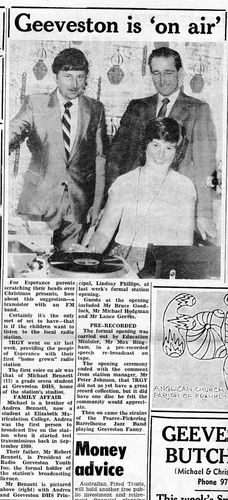

Transmitter 1984
- 1992
In 1992 the old fire station in School Road became available and under the guidance of the committee led by the secretary Tricia Hawthorne the station was able to broadcast within the immediate area on a limited basis.` The new studio was officially opened by Fran Bladel on 21st June 1992. - 1993
In 1993, former commercial radio broadcasters; Dan Garlick and Michael Naughton put forward a plan to the committee which resulted in the station adopting the name Huon FM with the station to become the voice for the whole Huon Valley. Dan Garlick became the Station Manager. - 1993-1998
During the period from 1993 to 1998 the station achieved many significant things for the Valley.- The first nationwide community radio breakfast show, The Red Eye Special took off in 1995.
- The Footy Show included the first live broadcasts of the local football finals in the Huon.
- The nationwide live broadcasts of the Cygnet Folk Festival.
- Becoming the designated broadcaster for the combined emergency services of the valley.
- Becoming the first Work for the Dole training centre in the Valley.
During the mid 1990s the station found it hard to retain active committees resulting in a number of cancelled committee meetings which resulted in difficulties in decision making.
There were also problems in attracting and retaining volunteers.
- 1998
In 1998 Fusion Australia was approached to take over the running of the station on a 3 year contract. They did so and ran the station until 2001. - 2001
In 2001, following a decision not to renew the management agreement with Fusion, the station again came under direct community control through the election of a new committee.
Following the decision to resume voluntary control John Woods and Carolyne Milne took over as joint managers. After some months John Woods dropped out and Carolyne continued to manage the station until 2010.
John Ladru took over as Treasurer and proceeded to resolve the station’s financial situation by carefully managing expenditure.
A major change was to move from the commercial radio based strict playlist format to a more flexible structure.
During the period when Fusion was managing the station the possibility of expending coverage to the Kingborough Municipality was explored and an informal approach made to consultants who recommended Herringback Ridge at Sandfly as the appropriate site.
As income improved and in particular we were able to fund essential items from Work for the Dole program funding the fabric of the building was improved. Projects included:
- A proper reception desk
- New internal phone system
- Hot water installed in kitchen
- False ceiling in the main office and office
- Installation of gas fire in main office
- Installation of reverse cycle air conditioner in Studio 1
- External painting of building under Work for the Dole Scheme
- New broadcast desk in main studio
- Replacement of gas fire with reverse cycle air conditioner in main office
- Replacement of air conditioning unit in Studio 1
- Replacement of power board
- New desk, studio fittings and equipment in Studio 1
- Rack installed in Studio 2 to hold equipment
Expansion into Kingborough
- 2004
In 2004 an Apparatus Licence was obtained for a transmitter at Herringback Ridge issued for the Telstra Tower. Negotiations with Telstra fell through and in that year Vodophone was contacted to ascertain whether it would consent to the use of its transmitter site. At this time the request was rejected. - 2007
Negotiations resumed in 2007 when a co-location agreement was signed with Crown Castle on who managed the Vodophone Herringback Ridge site.
Unsuccessful grant applications were made to Tasmania Community Fund and the Community Broadcasting Foundation in 2004, 2005 and 2006,
In 2007 we were successful in obtaining grants from Tasmanian Community Fund and the Community Broadcasting Foundation and a co-location agreement signed with Crown Castle.
Installation of the equipment was carried out by Powercom. - 2013
In 2013 a new mast prefabricated by Drysdale Engineering following the receipt of an $11,000 grant from Tasmanian Community Fund, $3,000 from Huon Valley Council and $2,000 from the Premier’s Discretionary Fund.
Jim Parrish assisted by John and David Milne project managed the work.
The new mast is hinged to enable it to be lowered by crane to enable easy access for repairs.
